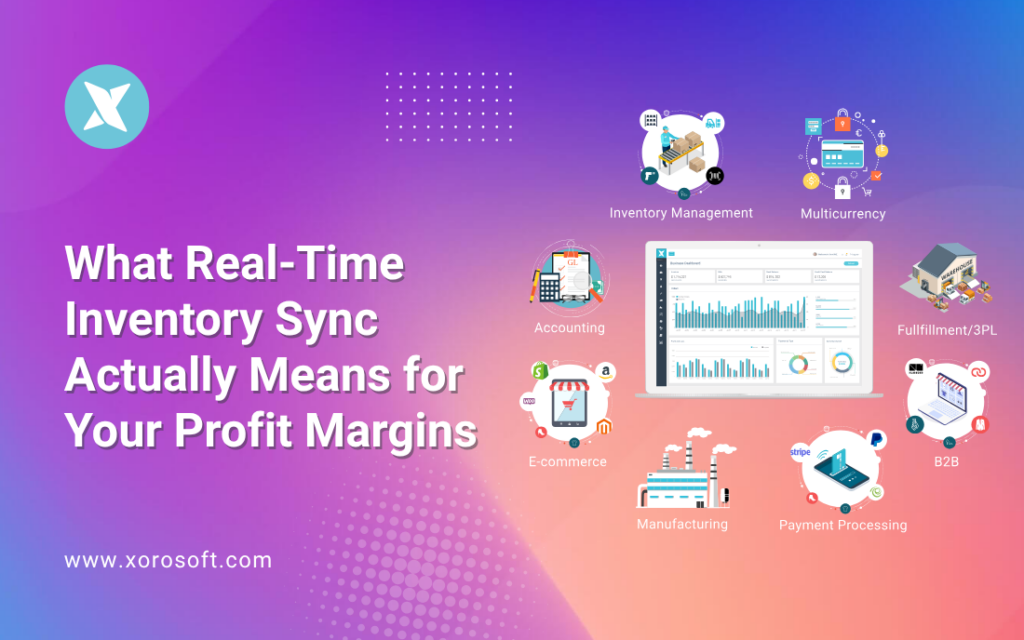
Inventory Synchronization Software for Ecommerce: Boost Profit Margins Effortlessly
Running a fast-growing ecommerce brand can be both exciting and overwhelming. Inventory synchronization software for ecommerce helps bridge that gap by giving you real-time visibility across every sales channel. Right from the start, it ensures that stock levels, financials, and operations stay perfectly aligned. As a result, your team spends more time on growth instead of fixing errors or chasing data mismatches. Moreover, leaders regain confidence because decisions rely on trusted numbers. In addition, the entire operation becomes simpler to manage.
Why Real-Time Inventory Sync Matters for Ecommerce Brands
Accurate data is the foundation of every profitable ecommerce business. However, when inventory updates lag across systems, errors multiply. Consequently, you face overselling, refund requests, and frustrated customers. In contrast, synchronized operations keep the promises you make on product pages and marketplaces.
With inventory synchronization software for ecommerce, each transaction instantly updates across platforms like Shopify, Amazon, and your warehouse system. Therefore, your back office runs smoothly, and your finance team always sees real numbers. Furthermore, this accuracy directly strengthens your margins, because fewer mistakes mean less wasted cash and time. In other words, clean data turns complexity into clarity. As a bonus, teams collaborate better because everyone is aligned.
Hidden Costs of Managing Inventory Without Synchronization Software
Even efficient teams encounter inefficiencies that quietly drain profits. Notably, the following issues appear as brands scale. Additionally, they compound during promotions and peak seasons.
1. Manual entries cause frequent errors. Typing or importing data increases risk and consumes hours. Additionally, it derails focus during peak sales and product launches.
2. Siloed platforms create confusion. Each channel tells a different story, leading to over- or under-stocking. By comparison, unified dashboards remove doubt and speed decisions.
3. Batch syncing slows reactions. Because updates happen only a few times per day, stock levels fall behind reality. Subsequently, support tickets rise and reviews suffer.
4. Safety stock traps capital. To stay safe, you over-order, tying up money that could fuel marketing. As a result, cash conversion slows and opportunities slip.
5. Teams fight fires instead of growing. When systems aren’t in sync, staff focus on corrections rather than improvements. Ultimately, morale suffers and strategic work stalls.
Nevertheless, these friction points fade once you implement inventory synchronization software for ecommerce. As a result, operational noise drops and profit protection increases.
Metrics That Prove Inventory Synchronization Works
You can measure effectiveness through clear, data-backed results. For example, watch these indicators during the first month. Likewise, compare them after major sales events to confirm stability.
| Metric | What It Measures | Why It Matters |
|---|---|---|
| Pick Accuracy | Correct orders shipped | Reduces reships and labor costs. |
| Order Cycle Time | Order to shipment duration | Shorter cycles improve reviews. |
| Cash Conversion Cycle | Inventory-to-cash speed | Faster turnover strengthens liquidity. |
Moreover, when data syncs instantly, forecasting accuracy improves. Consequently, purchasing becomes smarter and less risky. Thus, your margin story becomes predictable. As a result, finance can plan with confidence, and operations can scale without chaos.
How to Build Reliable Inventory Synchronization Software Workflows
Although the idea might sound technical, implementation is simpler than expected. To that end, follow this practical path. Additionally, involve both operations and finance so adoption sticks.
1. Identify All Data Touchpoints
Begin by listing every platform handling inventory — Shopify, Amazon, warehouse software, accounting tools, and spreadsheets. Then, trace how information flows between them. After all, visibility precedes control, and documentation prevents surprises.
Goal: Expose every point of delay.
Action: Map manual steps and sync timing.
Metric: Reduce manual updates to zero.
Eventually, this clarity reveals exactly where inefficiencies originate. As a next step, prioritize the highest-impact gaps first.
2. Centralize Your Source of Truth with Inventory Synchronization Software for Ecommerce
To maintain consistent numbers, consolidate data into one unified ERP or inventory synchronization software for ecommerce platform. Importantly, ownership of the master quantity must live in one place. Likewise, roles and permissions should be clear.
Goal: Create a single operational truth.
Action: Integrate all channels into one system.
Metric: 100% automatic synchronization.
Consequently, decisions across marketing, finance, and fulfillment stay consistent. Likewise, compliance and audit readiness improve, and reporting gets faster.
3. Enable Real-Time Updates Across Channels
Old systems depend on hourly or daily batch uploads. In contrast, modern solutions push updates in seconds. Therefore, latency disappears at the SKU level.
Goal: Eliminate lag between sales and stock updates.
Action: Use real-time API or webhook syncing.
Metric: Maintain average delay below five seconds.
As a result, your entire operation reflects current inventory instantly. Hence, overselling risk shrinks dramatically. Additionally, promotions become easier to run because stock positions are trustworthy.
4. Automate Adjustments for Returns, Restocks, and Bundles
Returns, restocks, and bundles constantly shift stock numbers. Because of that, automation keeps updates precise without human intervention. Similarly, automation protects against skipped steps during busy shifts.
Goal: Cut repetitive manual edits.
Action: Automate restocks, returns, and bundled-SKU changes.
Metric: Keep manual edits under five per week.
Additionally, automation improves data reliability and saves significant labor hours. Put differently, it gives time back to your team. In turn, that time funds continuous improvement.
5. Use Alerts to Stay Ahead of Problems
Anticipation beats reaction. Therefore, set up smart alerts to warn your team before stockouts or discrepancies occur. In addition, escalate unresolved alerts automatically.
Goal: Detect issues early.
Action: Enable low-stock and mismatch alerts in your ERP dashboard.
Metric: Resolve 90%+ alerts before they affect fulfillment.
Because you catch issues before customers do, you strengthen both trust and satisfaction. Meanwhile, ops leaders sleep better, and warehouse planning improves.
6. Automate Daily Reconciliation for Confidence
Waiting for weekly reports often leads to surprises. Instead, daily reconciliation verifies that numbers match across systems. Similarly, schedule a quick human spot-check to validate automation.
Goal: Maintain clean, consistent data.
Action: Schedule nightly automated reconciliations.
Metric: Keep data discrepancies below 0.1%.
Subsequently, accounting and operations work from the same figures. Beyond that, forecasting becomes simpler, and month-end closes faster.
7. Measure Improvements and Iterate
After stabilization, track progress regularly. Therefore, measure margin, accuracy, and turnaround time monthly to prove ROI. Additionally, publish a simple dashboard so everyone sees wins.
Goal: Connect data accuracy to financial performance.
Action: Compare pre- and post-sync metrics.
Metric: Achieve 10–30% improvement in order accuracy.
Thus, evidence replaces opinion in planning meetings. Ultimately, leadership sees the compounding value and continues investing.
Real-World Success with Inventory Synchronization Software for Ecommerce
An outdoor brand named ModernTrail struggled to manage Shopify, Amazon, and warehouse inventory through spreadsheets. However, after adopting inventory synchronization software for ecommerce, operations transformed. Notably, the changes appeared within a single quarter.
-
Pick accuracy improved from 93% to 99.6%.
-
Order cycle time dropped from four days to under three.
-
Cash conversion cycle shortened by 22%.
-
Refunds decreased substantially.
Consequently, the COO gained nearly six hours weekly for growth projects instead of reconciliation work. To illustrate, they redirected time to supplier negotiations and won better terms. In fact, those terms further improved margin and reduced lead-time risk.
One-Week Plan to Implement Inventory Synchronization Software for Ecommerce
Transformation doesn’t need months. Instead, results can start within days. Meanwhile, the process builds team confidence step by step.
| Day | Focus | Action | Outcome |
|---|---|---|---|
| Day 1 | Map systems | Identify all data sources and update paths. | Clear process map. |
| Day 2 | Choose your platform | Explore options on G2 or install Xorosoft ERP on Shopify. | Single platform selected. |
| Day 3 | Connect integrations | Link channels, warehouses, and accounting tools. | Real-time visibility achieved. |
| Day 4 | Configure automation | Add restock and return automation workflows. | Manual edits eliminated. |
| Day 5 | Validate metrics | Review performance KPIs and sync delay. | Confirm margin improvement. |
Meanwhile, document lessons learned and standardize them as SOPs. Thereafter, onboard new teammates quickly and consistently.
Long-Term Benefits of Inventory Synchronization Software for Ecommerce
Once synchronization is in place, performance gains compound. For instance, demand forecasting becomes more accurate, purchasing smarter, and cash flow steadier. Likewise, teams collaborate better because everyone sees the same live data.
Over time, the brand moves from reactive to strategic. Moreover, predictable processes allow leaders to scale confidently, knowing that back-office operations will keep pace with growth. Ultimately, inventory synchronization software for ecommerce doesn’t just streamline systems — it drives sustainable profit.
Strengthen Margins Through Smarter Operations
Running an efficient operation isn’t about working harder; it’s about connecting smarter. When your systems communicate seamlessly, errors disappear and margins widen. Therefore, take the next step today:
- Review trusted ERP rankings on G2.
- Try Xorosoft ERP on Shopify to experience synchronization firsthand.
- Book a live demo today
- Explore XoroONE
Because real-time visibility turns complexity into clarity, it’s time to make your operations as modern as your brand. Finally, enjoy the calm that comes from numbers you can trust and a back office that scales.









